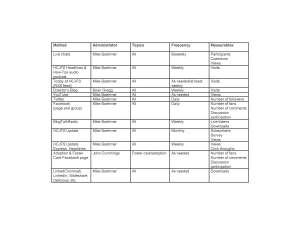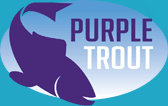Archive
Meeting with the Queen of Measurement

- Katie Paine, nationally recognized PR measurement expert, shared many insights during a visit to Cincinnati.
This week, I had the privilege of meeting with a member of public relations royalty: Katie Paine, the Queen of Measurement.
Paine, the New Hampshire-based author of Measuring Public Relationships: The Data-Driven Communicator’s Guide to Success, spoke to the Cincinnati Chapter of the Public Relations Society of America on snowy Feb. 9. Her topic: Social Media Measurement & Metrics.
She walked (sprinted?) the 25 of us who braved New England-like weather through 56 slides packed with information based on her work with a wide variety of clients.
Before the luncheon, 2010 Chapter President Chris Kemper (director of public relations at Cincinnati USA Chamber of Commerce) and I had the honor of meeting with Paine at the chamber’s Carew Tower offices. We picked her brain for nearly an hour before lugging her bag of books a few blocks through the snow to the Phoenix for the presentation.
I’m still trying to digest all of the information from the consultation and presentation. On top of that, I’ve been making my way through Avinash Kaushik’s comprehensive book Web Analytics 2.0: The Art of Online Accountability and Science of Customer Centricity.
Whew, my mind is churning.
I’ve got nine of Paine’s slides tacked to the wall in my cubicle at work – with a goal of boiling them down into a methodology that won’t take too much of our limited resources, but will help us fine-tune our strategic communication efforts. I’ve ordered her book.
Some of this seems strangely familiar. It’s based on the same principles drilled into my head while studying for the Accreditation in Public Relations (APR) in the 1990’s. I recall hearing similar measurement strategies and tactics at PRSA conferences in Anaheim, Chicago, New Orleans, New York and Salt Lake City.
- Start with a goal. Tie it to business objectives. Measure what’s important to top management…
- Use surveys, focus groups, one-on-one interviews, informal observation, best-practice research. Web analytics…
- Segment audiences. Craft concise messages. Measure message penetration. Determine if messages drove desired behavior changes…
But things have changed, too. That’s for sure.
The Internet has given us a boatload of data and tools (many free) for sorting and analyzing it.
With the emergency of social media, we’re able to engage in two-way conversations with key influencers in strategic audiences as never before. We can measure quite precisely the actions we’ve taken to produce desired outcomes.
Stay tuned for more specifics as I strive to implement more of these measurement practices in my daily work. Meeting with royalty makes me realize that I’m more of a servant, actually I am a public servant in my job.
And I’ve got a lot of work ahead of me — work that can be measured!!!
Aggregation elation
It’s a question I hear often: How do you get people to become fans of your organization’s Facebook page, follow its Twitter updates, listen to the BlogTalkRadio show, watch your YouTube channel…
There’s not a simple answer.
For one, you need to develop a strategic social media plan — one based on research, planning, implementation and evaluation. That will help you set goals, develop objectives, select target audiences, create content… and strategize ways to invite followers and fans.
For us (at the Hamilton County Department of Job and Family Services), this has included putting links on our Web site and in our online newsletter. Doing press releases. Including in PowerPoint presentations. Attending events and networking….
This week, we took another step — aggregating our social media feeds (Facebook, Twitter, YouTube, BlogTalkRadio, RSS feeds) together in a Social Media Center. This allows target audience members to quickly view all of our latest posts — and, hopefully, subscribe to them if they haven’t already.
Here’s a link to the Social Media Center.
I’d really appreciate your feedback.
Kudos goes to Randall Reese of LVX Communications. Randall, a graphic artist, developed the page.
Swimmin’ in SEO
Took a swim with a big fish in the Cincinnati social media pond recently. In a free Webinar, Steve Phillips of Purple Trout shared some tips for getting your Web site, blog and social media (Twitter, Facebook, LinkedIn, etc.) at the top of search engine results.
Steve said to keep in mind that people search by word, topic, event and product/service. He then filled an hour with lots of good information. Here are some highlights from my notes and Twitter stream.
Web site
• Tag pdf files: Put keywords in them, using Properties. (I tried this. It’s simple to do). You can tag videos and pictures like this, too, through Properties.
• Look up XML Site Maps with Google. (Google it.) Helps Google crawl entire Web site.
• Use Google Keyword Research Tool to find popular keywords.
• Ask as if each Web page is its own Web site. Should have own title and description to optimize.
• Important to put keywords in pay-for-click campaign ads to optimize for Google searches. Also landing page.
• Tag everything on your Web site — videos, pictures, PDF files, flash.
• Keywords placed strategically within Web site help with search engine optimization.
Blog
• It’s all about content and keywords. Tag posts.
• Put your blog’s URL in Google, Yahoo!, Bing. See if being crawled.
Do link-building: Feedburner, Technorati (Submit to Technorati), comment on blogs.
• Put keyword in headline and post entry. Put headline in Google and search for results.
• Don’t just say “I agree” when commenting on other blogs. Contribute to the conversation.
• Facebook has real-time indexing. Keep “posts by everyone” in mind Use keywords when doing status updates.
• Use all tabs (links, photos, video, events boxes…).
• Ask questions to engage participants.
• Invite people to Events
• Optimize Twitter: Use keywords in Tweets – company name as much as possible. Include helpful links. Use company name, products, services. But be helpful.
• Participate in Answers section. Can search keywords for questions in your industry. Be helpful. Answer Q’s.
• To improve search results, have profile 100% complete. Use targeted keywords in headline.
Hope this wasn’t overly technical. Not sure I understand everything! Thanks to Steve for sharing this good information. It was nice swimming in his pond.
E8QE3JS8TU5E
Tweet, tweet… some guiding principles
 After being on auto-tweet for a few months (as @MikeBoehmer57, @HamiltonCoJFS, @NTUnityCincy), I've been rethinking my Twitter strategy in recent weeks.
After being on auto-tweet for a few months (as @MikeBoehmer57, @HamiltonCoJFS, @NTUnityCincy), I've been rethinking my Twitter strategy in recent weeks.
As I mentioned in the previous post, Twitter has helped me build and nurture a number of positive relationships. I’ve had the opportunity to learn a great deal from many people and, hopefully, share some of my knowledge and experience in return. We’ve had some laughs and offered support as we advanced in our professional and personal lives.
Twitter also has allowed me to keep strategic audiences updated at work, through @HamiltonCoJFS. It has permitted me to let people know about upcoming events at my church, @NTUnityCincy.
After reading dozens of articles and blog posts, attending many workshops, talking with a wide variety of social media pioneers, and using Twitter pretty-much daily for almost 18 months, I'm formulating some guiding principles for my use of Twitter. I want to stress that these are subject to change as I walk a bit further along this path of discovery.
(1) Stay away from politics and religion, except maybe in direct messages (DM) with like-minded folks.
(2) When someone follows me, follow them back. Unfollow if they over-post, offer information not relevant to me, do mean-spirited tweets… Possibly follow again down the road to see if they've changed. Maybe connect on LinkedIn or another social media network.
(3) Be positive. Don't use as an outlet to vent or complain.
(4) Offer encouragment to followers whenever possible. Thank them when they retweet (RT).
(5) Try to share helpful links related to public relations, marketing and social media every day. Give more than I take.
(6) Help people promote worthy causes, especially those related to cancer research or support.
(7) Build and nurture relationships that will help maintain a positive image for my employer. Share information that will help our customers, especially those looking for employment or services to help them during extended unemployment.
Those are some that come to mind at this time. I'll add more as time goes along. I welcome any ideas, and would love to hear your guiding principles when it comes to Twitter.
Getting feedback from fans of our page
![pablo[1] pablo[1]](https://mikeboehmer57.files.wordpress.com/2009/09/pablo11.jpg?w=595) I continue to rely on my accreditation training while doing strategic public relations with social media. The four-step process was drilled into my mind while studying for the Accredited in Public Relations (APR) from the Public Relations Society of America (PRSA) over a decade ago. (Yes, I’m that old, er young!)
I continue to rely on my accreditation training while doing strategic public relations with social media. The four-step process was drilled into my mind while studying for the Accredited in Public Relations (APR) from the Public Relations Society of America (PRSA) over a decade ago. (Yes, I’m that old, er young!)
Research.
Planning.
Implementation.
Evaluation.
With that in mind, we conducted an online survey of fans of the Hamilton County (Ohio) Department of Job and Family Services’ Facebook page. At the writing, the page has 199 fans. (Anxiously awaiting No. 200!!!). Thirty people participated in the survey, giving us much-wanted feedback as we seek to continuously improve the page we launched in late January 2009.
Here are some findings that may be helpful to you.
First, how did we get people to participate? We shared a link on Facebook and Twitter offering a free t-shirt to those who participated. That brought in a few folks. Then, we e-mailed a link to subscribers to our online newsletter. That brought in most. (By the way, the t-shirts were leftovers from our last tax levy campaign. They had been taking up storage space. Don’t tell anyone!)
What did people say? Well, they primarly have become fans to learn about services and upcoming events. One-third also want to use the page to ask questions and offer comments.
Are we hitting the mark? Four in 10 always find our status updates valuable. Six in 10, sometimes. So zero didn’t find them valuable!
What’s most important? Most want information about Medicaid. No surprise. It’s our largest program.
How often? Most want status updates weekly or as-needed, followed closely by daily.
Who? We’re getting visits from our top two strategic external audiences — social service partners and customers.
Don’t give a tweet. Only 14 percent also follow us on Twitter (@HamiltonCoJFS)
Affirmation. Nobody slammed us. Instead, we got comments such as: “I am not always able to read printed information, so it is convenient to have the information available on my facebook when I sign in.”
These are a few highlights culled quickly on a busy Saturday morning. We’ll continue to evaluate the data. Also, I’ve started inviting people to focus groups, luring them with a invite for “free food.” I’ll probably spring for some pizza from my pocketbook. Times are tight, but I really need the info to keep that Four Step Process humming.
Hope you find this helpful as we forge this social media path together!
Many choices
![MPj04384930000[1] MPj04384930000[1]](https://mikeboehmer57.files.wordpress.com/2009/08/mpj043849300001.jpg?w=227&h=300)
Take what you like — and leave the rest.
Somebody gave me that piece of advice when I was checking out something new years ago. I’ve found it helpful while planning a social media strategy.
For example, I got a suggestion from someone I really respect in the public relations field that just didn’t work in our situation. (I’m so grateful that he took the time to review a draft of our nearly final social media strategy.)
He recommended that we get our organization’s various program experts involved directly in blogging and other social media — that we should develop a social media policy and then turn them loose. I’ve read case studies where this has been effective for many organizations.
However, it’s not applicable in ours. The main reason is that our program experts are very busy doing their jobs. We already use them in a speakers bureau, in live chats, in some media interviews… The timing is not right to add more PR tasks to their list. There are lots of other reasons, too.
So we chose not to incorporate this expert’s ideas into our plan. Even though this may work for others, it’s not a fit for us.
Have you had a similar experience — a time where the prevailing school of thought just didn’t work for your organization? I’d love to hear your experience.
Getting into the tactics

Now that we’ve (1) crafted the Situation Statement, (2) established Social Media Goals, (3) written Overall Objectives, and (4) defined Strategic Audiences — it’s time to get into tactics.
This table describes our various social media methods, administrators (who does the actual posting, chat facilitating, etc.), topics, frequency and measurables.
Next, we’re going to establish measurable objectives for each of the methods based on past experience. For example, our live chats have averaged 10 participants, 15 questions and 74 views. We’ll set a goal of maintaining or exceeding that level.
We’ll include a weekly production schedule and several appendecies such as the breakdowns of Facebook fans and Twitter followers.
And, we plan to get more feedback through surveys and focus groups. A survey of 200-some Twitter followers drew just nine participants, but did give us a little insight. But we want more understanding of how our audiences use social media, so we’ll conduct focus groups and one-on-one interviews.
Any feedback on our methodology from you would be greatly appreciated!
Putting the social media plan in writing

We’ve drafted a social media strategy for the Hamilton County Department of Job and Family Services. I’ll be sharing portions here to get your feedback. Here’s the start….
Situation
Due to the economic downturn, the Hamilton County Department of Job and Family Services finds itself serving more customers with fewer employees. More than a third of the agency’s workers have been laid off or retired early as the result of a 50-percent decline in state funding. Yet demands for services such as Medicaid, food stamps, cash assistance, child support, subsidized child care, child protection and adult protection have increased. Hamilton County leadership has stressed the need to take innovative approaches to address these challenges. One innovation involves implementing a social media strategy.
Social media goals
• Improve accessibility and transparency — respond to customers’ needs and “put a face” on the agency
• Engage audiences (Don’t just broadcast messages)
• Complement and enhance successful communication processes already in place (media relations, speakers bureau, special events)
Overall objectives
• To relieve pressure on crowded waiting rooms and busy call centers
• To build and strengthen relationships with key influencers in target audiences
• To make potential customers aware of the agency’s many services
• To help new customers efficiently access the agency’s services
• To give quick answers to customers’ questions
• To reinforce positive perceptions of the agency by its peers
Strategic audiences
• Clients/customers, especially those unfamiliar with agency programs/services
• Social service partners
• Taxpayers/voters
• Overseers
• Government peers
• Employees
• Former employees (retired, laid off, moved on to other jobs)
Video of presentation
Segmenting audiences
![MPj04393430000[1] MPj04393430000[1]](https://mikeboehmer57.files.wordpress.com/2009/06/mpj043934300001.jpg?w=300&h=300) Please excuse me if this post is too elementary for you PR veterans, but — based on the comments of a media-turned-PR person the other day — I thought I’d briefly touch on one of the basics: Audience segmentation.
Please excuse me if this post is too elementary for you PR veterans, but — based on the comments of a media-turned-PR person the other day — I thought I’d briefly touch on one of the basics: Audience segmentation.
Here’s an example of how we segmented the internal audience at the Hamilton County Department of Job and Family Services a few years back:
1. Executive Team
2. Middle managers
3. Supervisors
4. Frontline staff
Then, we developed research, planning, implementation and evaluation methods for each audience.For example, research with the Executive Team consisted of one-on-one interviews about communication, asking for their views on what worked and what didn’t. We surveyed middle managers. And we did separate focus groups with supervisors and frontline staff.
As time went on, we developed strategies for communicating within each segment. In one of three major programs areas, for instance, we identified “opinion leaders” and worked directly with them. In another, we pulled together a list of unit meetings and supplied talking points for supervisors to use in those meetings.
We continued to evaluate through surveys, focus groups and informal observation. We reported our findings and made adjustments over time.
The same practice can be used to make your social media strategy more effective. The more you break down your audience into subgroups, the more effective you’ll be in achieving your goals and objectives. You’ll create strategies that deliver results as you implement them. And you’ll make adjustments based on what you learn as you evaluate. It’s a continuous improvement loop.
Hope this was helpful to you newbies. It was a good refresher for me as I continue to write a social media strategy for my employer.
![Reblog this post [with Zemanta]](https://i0.wp.com/img.zemanta.com/reblog_e.png)

